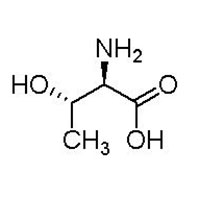



| N/A |
| Packing | |
|---|---|
| Storage | Powder -20°C 3 years 4°C 2 years;In solvent -80°C 6 months, -20°C 1 month |
| Shipping | Room temperature in continental US; may vary elsewhere |
Tel: 0086-25-52397805
Email: info@alchemist-chem.com

| Common Names | DL- serine | ||
|---|---|---|---|
| Structure |  |
||
| CAS No. | 80-68-2 | Boiling Point (℃) | 345.8±32.0 °C at 760 mmHg |
| Molecular Weight | 119.119 | Melting Point (℃) | 244 °C (dec.)(lit.) |
| Density | 1.3±0.1 g/cm3 | Vapor Specific Gravity | N/A |
| Molecular Formula | C4H9NO3 | Flash Point (℃) | 162.9±25.1 °C |
| Solubility | 200 g/L (25 ºC) | Autoignition Temperature (℃) | N/A |
| Personal Protective Equipment | Eyeshields;Gloves;type N95 (US);type P1 (EN143) respirator filter | ||
|---|---|---|---|
| Hazard Codes | T+:Very toxic | ||
| Safety Phrases | S1-S28-S45 | ||
| RIDADR | NONH for all modes of transport | ||
| WGK Germany | 3 | ||
| SYMPTOMS | PREVENTION | FIRST AID | |
| Inhalation | Cough. Sore throat. | Use local exhaust or breathing protection. | Fresh air, rest. |
| Skin | Redness. Burning sensation. Itching. | Protective gloves. | Remove contaminated clothes. Rinse and then wash skin with water and soap. |
| Eyes | Redness. Pain. | Wear safety goggles. | First rinse with plenty of water for several minutes (remove contact lenses if easily possible), then refer for medical attention. |
| Ingestion | Abdominal pain. Nausea. Vomiting. | Do not eat, drink, or smoke during work. Wash hands before eating. | Rinse mouth. Induce vomiting (ONLY IN CONSCIOUS PERSONS!). Refer for medical attention. |
| Description | DL-Threonine, an essential amino acid, has the potential to treat hypostatic leg ulceration[1]. | ||
|---|---|---|---|
| Target | Km: 100-400 μM (amino acid transporter b0,+)[1] | ||
| In Vitro | DL-Lysine (Lys) is a high affinity, basic amino acid substrate for amino acid transporter b0,+ with Km value ranging from 100-400 μM[1]. | ||
| References | [1]. Harvey SG, et al. L-cysteine, glycine and dl-threonine in the treatment of hypostatic leg ulceration: a placebo-controlled study. Pharmatherapeutica, 01 Jan 1985, 4(4):227-230. | ||